When people envision a thriving vegetable garden, they often picture a pastoral scene, far out in the country behind a picket fence. Rarely does the first image that comes to mind appear as pots on a balcony, a collection of various-sized containers on a patio closely neighbored by other buildings, or a postage-stamp-sized backyard stuffed with plants in every little nook.
However, even in the city, if you have a little bit of outdoor space, you can grow some of your own food. The rewards are many!
Why Should You Grow Food in the City?
One of the greatest aspects of growing your own vegetables is knowing that you are growing food that is pesticide-free and high in nutrition.
That produce at the store isn’t nearly as nutritious (or tasty) as what you grow in your own backyard. Why? Because it’s harvested well before it’s actually ripe so that it can have a long enough shelf-life to reach your grocer’s location. The longer you can keep the vegetable on the vine or growing in the soil, the more nutrient-rich that vegetable will be. Vegetables start losing nutrients as soon as they’re harvested, and quality diminishes as natural sugars are turned into starches.
For the tastiest veggies with the best nutrition, try growing a few of these nutrient-dense foods in your own garden. Many of these superfoods can be grown in containers, so even if you don’t have a lot of garden space, you can still enjoy the thrills that gardening brings.
Never forget the positive effects of gardening on your mood – it’s nearly as important as the bounty you’ll bring in. A bit of sunshine, green plants, the smell of the soil, and some fresh air on a daily basis is good for the soul, particularly if you spend most of your day roaming a concrete jungle.
Grow These 10 Veggies in Your Urban Garden
Some vegetables will work better in a small urban garden than others. All of the vegetables on this list were selected because they can be grown in containers or sown into the ground, depending on your situation.
1. Broccoli

Nutrition Info
- Serving Size: 1 cup
- Calories: 31
- Fat: 0.3 g
- Carbohydrates: 6 g
- Protein: 2.6 g
How to grow
Plant seeds in mid to late summer to be ready for the fall harvest. Broccoli thrives in full sun and well‐drained soil. This variety of broccoli has a tendency to give yields from side shoots past its first harvest and can handle light frost with no problem. Broccoli is a cruciferous vegetable full of phytonutrients and antioxidants, as well as vitamin A, vitamin K, folate, and B‐complex vitamins.
- Start: For spring harvest, start indoors 4‐6 weeks before the last frost. For fall harvest, start indoors 2-3 months before the first frost. Transplant into your garden when the plants are 3″ tall and the root systems are established.
- Plant: Sow seeds in ¼” soil. Plants prefer full sun with 15‐18” of space between each plant.
- Harvest: 60‐90days
Container instructions: If you are growing your broccoli in containers, be sure that it is at least 18-inch diameter and a minimum of 3 gallons in size. Broccoli requires a container with good drainage. Only put one plant in each container, as they require lots of room to grow. Use a light soil.
2. Peas
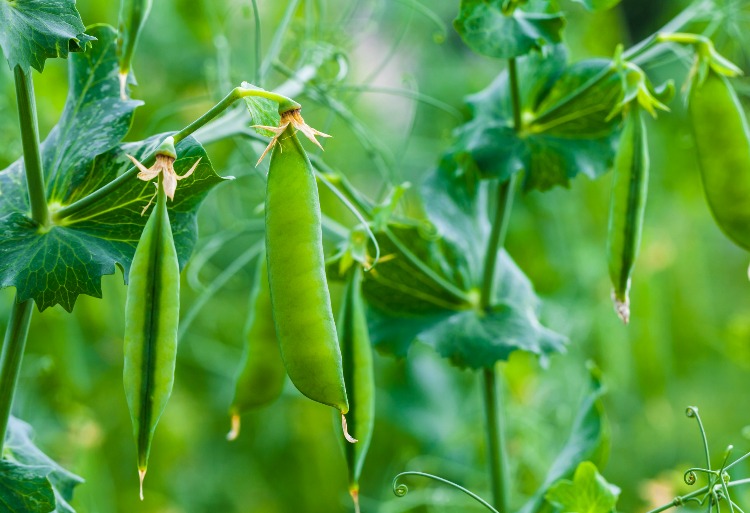
Nutrition Info
- Serving Size: 1 cup
- Calories: 118
- Fat: 0.6 g
- Carbohydrates: 21 g
- Protein: 8 g
How to grow
This is a winter loving plant that is resistant to frost, and one of the easiest vegetables to grow. Sweet peas are a good source of protein, fiber and provide 8 different vitamins including vitamin A, B6, and K.
- Start: 3-4 weeks before your last frost date. Peas prefer to be cool and can germinate in temperatures as low as 45 degrees. Seeds can be started indoors or sown directly into the soil.
- Plant: Prefers to be planted in full sun in 1” deep soil, plant seeds 6” apart.
- Harvest: 50 days
Container instructions: Use the largest pot you can find, because peas like to spread out. Add a generous amount of peas to the pot, spread out evenly across the surface, then top it with another couple of inches of soil. If you use fertilizer, don’t use much, as the nitrogen can negatively affect your harvest. Keep the soil moist and locate it in full sun. Be sure to have a trellis that the peas can climb for the most bountiful harvest.
3. Beans (especially navy beans, great northern beans, kidney beans)
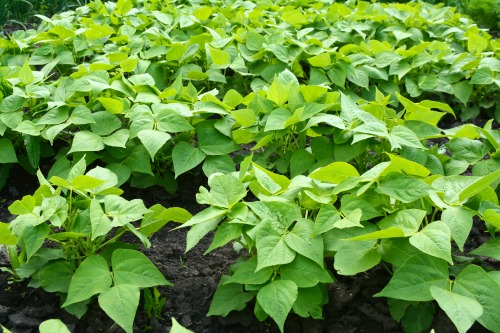
Nutrition Info
- Serving Size: 1 cup
- Calories: 245
- Fat: 1 g
- Carbohydrates: 45 g
- Protein: 15 g
How to grow
Beans should be planted in the early summer. Staggering your plantings will give continuous yields. Beans are very high in fiber, and Vitamins A, C, and K, as well as minerals like iron, calcium, magnesium, manganese, and potassium.
- Start: Outdoors once all danger of frost has passed
- Plant: 2‐4 inches apart in full sun
- Harvest: Beans are ready after 58 days. Pick when the plant is dry. Frequent picking encourages larger harvest.
Container instructions: Depending on the type of beans you are growing, you may require a trellis. Bush beans don’t require trellising or staking, which could make them a better choice for a container. Choose a container that is at least 8-10 inches deep. You can plant 9 seeds for every foot of surface space. Beans need plenty of water, particularly when they are in pots.
4. Brussels sprouts
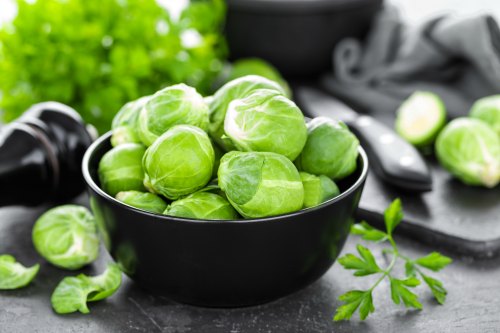
Nutrition Info
- Serving Size: 1 cup
- Calories: 38
- Fat: 0.3 g
- Carbohydrates: 8 g
- Protein: 3 g
How to grow
Brussels sprouts are slow-growing plants that thrive in cool weather. In fact, Brussels sprouts that mature in hot weather will be bitter and unpleasant. They even continue to grow after a light frost, making them the perfect addition to your fall garden.
- Start: Indoors at least 4-6 weeks before the last frost.
- Plant: Transplant seedlings 12-24 inches apart. Brussels sprouts thrive in raised beds with well-fertilized soil. Mulch after a few weeks to help maintain adequate moisture at the roots.
- Harvest: Harvest sprouts from the bottom once they reach about an inch in diameter.
Container instructions: To grow Brussels sprouts in a container, you need one that is at least 12 inches in diameter and 12 inches deep. Prepare the soil several days before planting by fertilizing it well, then soaking the soil until the water begins to drain out the bottom. Plant only one per container. Move them out of the direct sun during the hottest part of the day.
5. Tomatoes
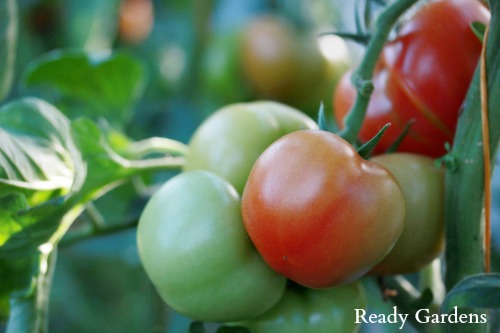
Nutrition Info
- Serving Size: 1 cup (sliced or chopped)
- Calories: 32
- Fat: 0.4 g
- Carbohydrates: 7 g
- Protein: 1.6 g
How to grow
Tomatoes can be planted in the early spring and then again, midsummer. Tomatoes are a good source of Vitamin A, C, K, E, Potassium, thiamine, and Niacin. As well, they supply antioxidants (including lycopene) that are powerful fighters of cancers, including colon, prostate, breast, endometrial, lung, and pancreatic tumors.
- Start: Start seeds indoors to give a head start. Transplant when full leaves have set. Harden young plants for 1‐2 weeks before permanently planting.
- Plant: Plant seeds ¼ “‐1/2” deep. Once transferred to garden, space tomato plants 36” apart for optimum harvest. Tomatoes should be planted in full sun.
- Harvest: 62‐100 days
Container instructions
Tomatoes require very large containers, at least 18 inches in diameter. They need to be deep and well-drained to allow the plant to develop a hardy root system. Keep the soil consistently moist, but not wet. Provide support for the tomato plants in the form of a cage or stakes. Add diluted liquid fertilizer every two weeks, and keep the plants in full sun.
6. Bell peppers
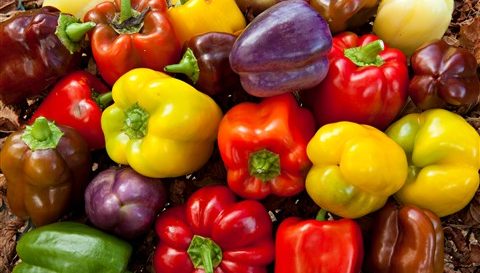
Nutrition Info
- Serving Size: 1 cup
- Calories: 46
- Fat: 0.4 g
- Carbohydrates: 9 g
- Protein: 1.5 g
How to grow
Peppers should be planted after the last frost. The more peppers that are harvested, the more the plant will produce.
- Start: Indoors, 4‐6 weeks before the last frost
- Plant: After all danger of frost has passed, move seedlings outdoors and plant in full sun, 15-20 inches apart.
- Harvest: Peppers are ripe after 75 days. You can pick them when they’re still green or allow them to ripen to red.
Container instructions: Choose a pot that is at least 16 inches deep, with good drainage. Water well-fertilized soil and allow it to drain thoroughly before planting. Plant your pepper seedlings in full sun, turning the pot on a regular basis to keep them growing straight. You may need to stake your plants due to the weight of the peppers.
7. Beets
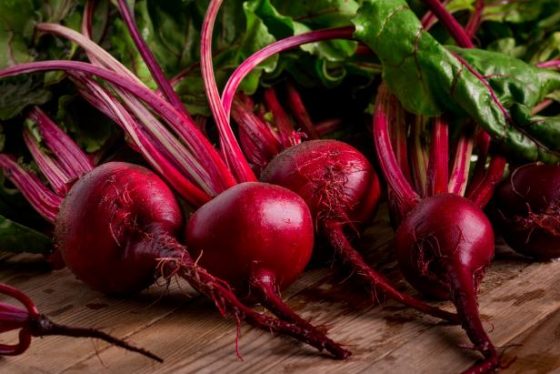
Nutrition Info
- Serving Size: 1 cup
- Calories: 59
- Fat: 0.2 g
- Carbohydrates: 13 g
- Protein: 2.2 g
How to grow
Both the leafy green tops and the tuberous root are edible and provide abundant nutrients. Beets are a high source of fiber, folates, vitamin C, carotenoids, B complex vitamins, and potassium. Beets are small plants with large dark‐green leaves.
- Start: Seeds can be started indoors or directly sown as soon as the ground can be worked. For more successful germination, soak seeds overnight in a damp towel before planting.
- Plant: Early spring or midsummer. Plant beet seeds in 1/2’” deep soil, 1” apart and thin weakest seedlings to the desired spacing. Keep soil evenly moist to prevent beetroots from getting woody. For a longer harvest, stagger beet plantings every 2‐3weeks.
- Harvest: 60 days. If not harvested on time, it continues to grow, develops cracks and becomes unappetizing because it develops an overly fibrous consistency.
Container instructions: Choose a pot that is at least 6 inches deep. Be sure that it has excellent drainage since beets do not do well in soggy soil. Too much nitrogen in your soil will result in huge, luxuriant leaves at the top, and not much development in the roots. Water only at the base of the plant to help prevent disease and pests.
8. Salad greens
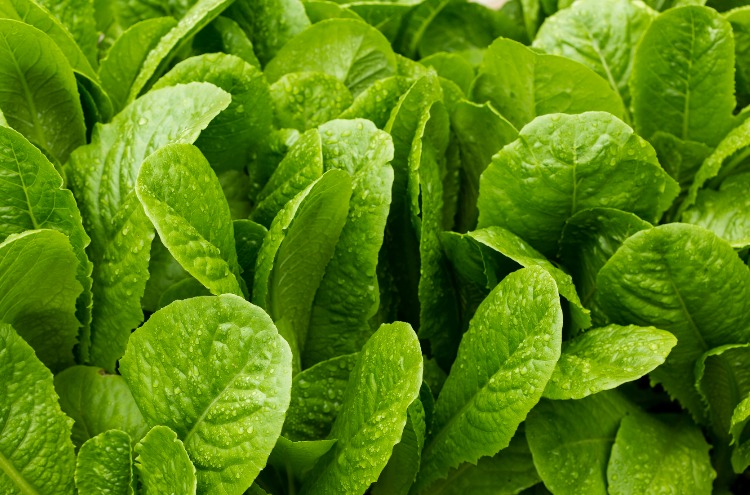
Nutrition Info
- Serving Size: 1 cup
- Calories: 5
- Fat: 0 g
- Carbohydrates: 1 g
- Protein: 0.5 g
How to grow
Lettuce is an ideal urban garden plant. In fact, you don’t even have to have outdoor space to grow it – a warm, sunny windowsill will provide you with all the salad greens you need. Succession planting ensures you’ll have salad greens throughout the season.
- Start: Sow seeds directly into the soil. Stagger plantings every 2-3 weeks.
- Plant: Plant seeds at a depth of ½” and 6‐8 inches apart, in full or partial sun, and the cooler temperatures of spring or fall.
- Harvest: 39-45 days. depending on the specific lettuce
Container instructions: Choose a pot that is 6-12 inches in diameter with excellent drainage. Too much water at the roots will cause rot. This being said, lettuce is more than 90% water, so frequent shallow watering is vital. As lettuce grows, cut the outside leaves to enjoy while allowing the inside leaves to continue growing, for a cut-and-come-again harvest.
9. Carrots
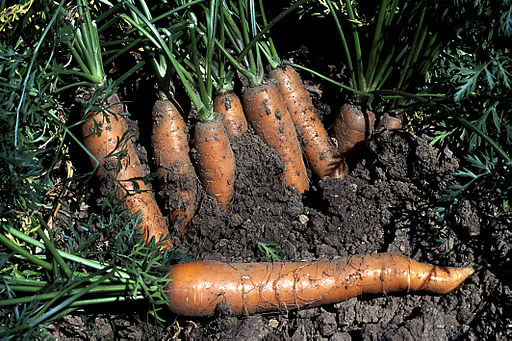
Nutrition Info
- Serving Size: 1 cup of slices
- Calories: 50
- Fat: 0.3 g
- Carbohydrates: 12 h
- Protein: 1.1 g
How to grow
Carrots prefer cooler weather and should be grown in the fall, winter and early spring. They are one of the easiest vegetables to grow. Smaller carrots have a sweeter flavor, so harvest early.
- Start: Outdoors, after danger of frost
- Plant: In full sun, 3 seeds per inch. Thin seedlings to 2‐3 inches apart when they are 1‐2inches high – don’t overwater
- Harvest: Carrots are ready in about 73 days
Container instructions: Since carrots are root vegetables, you will want to choose a container based on depth. A great and inexpensive way to grow carrots is in the holes in cement blocks. Plant carrots in a lightweight soil medium that drains well. They require very regular watering when planted in containers. Mulch them to maintain moisture and keep down weeds.
10. Dark greens
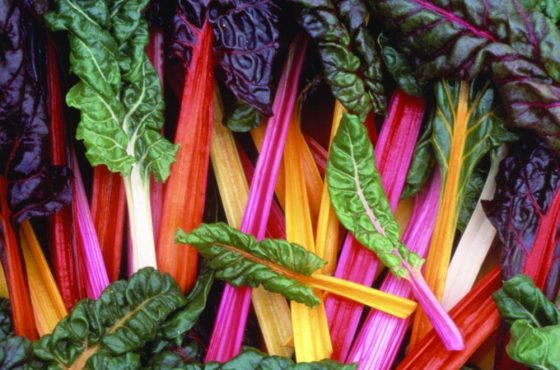
Nutrition Info
- Serving Size: 1 cup
- Calories: 33
- Fat: 0.6 g
- Carbohydrates 6 g
- Protein: 2.9 g
How to grow
Greens like Swiss chard, spinach, and kale are easy to grow. They can be planted 2‐3 weeks before the last frost and individual leaves can be harvested throughout the growing cycle, for a “cut-and-come-again” harvest.
- Start: Sow seeds directly into the soil at a depth of ½” and 6‐8 inches apart.
- Plant: Prefer full or partial sun and the cooler temperatures of spring or fall.
- Harvest: 50‐60 days. depending on the green
Container instructions: Choose a pot that is at least 6 inches deep and 6 inches in diameter. On a hot day, move your pots of greens to the shade. These greens are sweeter and less bitter when grown in cooler weather.
What are you waiting for?
If it isn’t planting time, it’s planning time! In the off-season, you can often acquire pots, amendments, and seeds. Decide well ahead of time what you intend to plant, and mark important dates on your calendar:
- First frost
- Last frost
- Dates for starting different varieties of seeds
- Dates for sowing seeds directly into the soil
- Dates for transplanting seedlings outdoors
- Approximate harvest dates
Before you know it, your urban oasis will be bursting with wholesome produce and you’ll wonder why you waited so long to start growing your own food.

